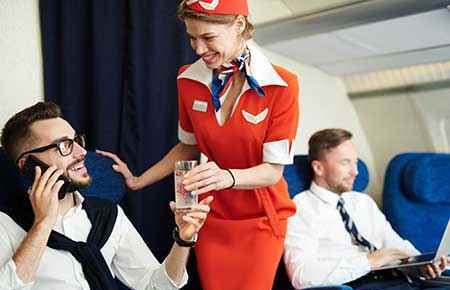
Flight Attendant
Summary
Flight attendants provide routine services and respond to emergencies to ensure the safety and comfort of airline passengers.
What they do
Flight attendants typically do the following:
- Participate in preflight briefings with the pilots, to discuss cabin conditions and flight details
- Conduct preflight inspections of emergency equipment
- Demonstrate the use of safety equipment and emergency equipment
- Ensure that passengers have their seatbelts fastened when required and that all other safety requirements are observed
- Serve and sell beverages, meals, or snacks
- Take care of passengers’ needs, particularly those with special needs
- Reassure passengers during the flight, such as when the aircraft hits turbulence
- Administer and coordinate emergency medical care, as needed
- Provide direction to passengers, including how to evacuate the aircraft in an emergency
Airlines are required by law to provide flight attendants for the safety and security of passengers. The primary job of flight attendants is to keep passengers safe, ensuring that everyone follows security regulations and that the flight deck is secure. Flight attendants also try to make flights comfortable and stress free for passengers. At times, they may deal with passengers who display disruptive behavior.
Work Environment
Flight attendants work primarily in the cabin of passenger aircraft. Dealing directly with passengers and standing for long periods can be stressful and tiring. Occasionally, flights encounter air turbulence, which can make providing service more difficult and causes anxiety in some passengers. Handling emergencies and unruly customers also can be difficult and cause stress.
Flight attendants spend many nights away from home and often sleep in hotels or apartments shared by a group of flight attendants.
How to become a Flight Attendant
Flight attendants receive training from their employer and must be certified by the Federal Aviation Administration (FAA). Flight attendants need a high school diploma or the equivalent and work experience in customer service.
Applicants must be at least 18 years old, be eligible to work in the United States, have a valid passport, and pass a background check and drug test. They must have vision that is correctable to at least 20/40 and often need to conform to height requirements set by the airline. Flight attendants also may have to pass a medical evaluation.
Flight attendants should present a professional appearance and not have visible tattoos, body piercings, or an unusual hairstyle or makeup.
Pay
The median annual wage for flight attendants was $56,640 in May 2019. The median wage is the wage at which half the workers in an occupation earned more than that amount and half earned less. The lowest 10 percent earned less than $29,270, and the highest 10 percent earned more than $80,940.
Job Outlook
Employment of flight attendants is projected to grow 17 percent from 2019 to 2029, much faster than the average for all occupations.
Many airlines are replacing smaller aircraft with new, larger planes that can accommodate a greater number of passengers. As a result, this change may increase the number of flight attendants needed on some routes.
Similar Job Titles
Flight Attendant; Flight Attendant, Inflight Services; Flight Attendant/Air Transportation Supervisor; Flight Attendant/Inflight Manager; Flight Attendant/Inflight Supervisor; In-Flight Crew Member; International Flight Attendant; Lead Instructor/Flight Attendant; Purser
Related Occupations
Psychiatric Aide, Occupational Therapy Aide, Transportation Security Screeners, Ambulance Driver and Attendant, Transportation Attendant
More Information
The trade associations listed below represent organizations made up of people (members) who work and promote advancement in the field. Members are very interested in telling others about their work and about careers in those areas. As well, trade associations provide opportunities for organizational networking and learning more about the field’s trends and directions.
- Association of Flight Attendants - AFA-CWA is the flight attendant union organized by flight attendants for flight attendants.
- Flight Attendant Association - coming soon
- Association of Professional Flight Attendants - APFA is a strong and independent Union comprised of 28,000 hard-working Flight Attendants of American Airlines.
Magazines and Publications
- Flightess
- Airways Magazine (Flight Attendant archives)
The opportunity to travel attracts many Flight Attendants to their career. That opportunity comes with serious responsibilities for the safety of passengers and other airline personnel. Flight Attendants greet passengers, help them find their seats and stow their bags… serve meals… and cope with turbulence, airsickness, and disruptive travelers. To keep passengers safe, flight attendants also instruct passengers in the use of equipment like seat belts and oxygen masks, and are ready to help passengers evacuate in an emergency landing. Flight attendants work nights, weekends, and holidays —especially early in their careers, because more experienced staff usually fly the most desirable routes and schedules. A high school diploma is generally required to enter the field. While each airline has specific requirements, in general, candidates should be in excellent health, able to speak clearly, and be willing to relocate. Travel experience, customer service skills, and speaking a foreign language would all be an advantage. Candidates could expect several weeks of concentrated training and many months of serving as a substitute attendant before working full time. This career requires confidence, reliability and graciousness— because for most passengers, the flight attendant is the face of the airline.
Content retrieved from: US Bureau of Labor Statistics-OOH www.bls.gov/ooh,
CareerOneStop www.careeronestop.org, O*Net Online www.onetonline.org
